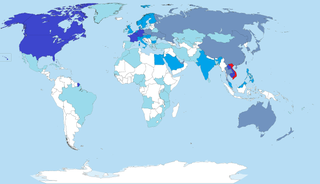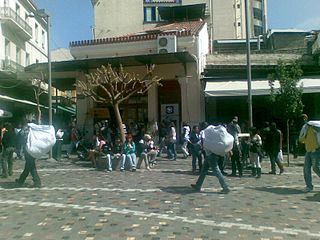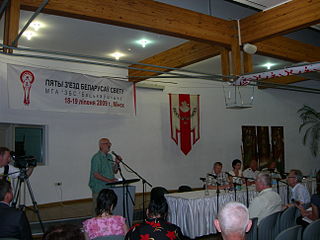
Human capital flight refers to the emigration or immigration of individuals who have received advanced training at home. The net benefits of human capital flight for the receiving country are sometimes referred to as a "brain gain" whereas the net costs for the sending country are sometimes referred to as a "brain drain". In occupations that experience a surplus of graduates, immigration of foreign-trained professionals can aggravate the underemployment of domestic graduates, whereas emigration from an area with a surplus of graduates leads to better opportunities for the ones left. The other way around, with occupations or areas with a lack of graduates, emigration will lead to more difficulties concerning the area.

Human migration involves the movement of people from one place to another with intentions of settling, permanently or temporarily, at a new location. The movement often occurs over long distances and from one country to another, but internal migration is also possible; indeed, this is the dominant form of human migration globally. Migration is often associated with better human capital at both individual and household level, and with better access to migration networks. Age is very also important for both work and non-work migration. People may migrate as individuals, in family units or in large groups. There are four major forms of migration: invasion, conquest, colonization and emigration/immigration.

The Australian continent was first settled when ancestors of Indigenous Australians arrived via the islands of Maritime Southeast Asia and New Guinea over 50,000 years ago.

Overseas Vietnamese refers to Vietnamese people living outside Vietnam in a diaspora, by far the largest community of which live in the United States. The official number of the Vietnamese diasapora is about 4.5 million Overseas Vietnamese. A majority left Vietnam as economic and political refugees after the 1975 capture of Saigon and the North Vietnamese takeover of the pro-U.S. South Vietnam. The Vietnamese diaspora is the fifth largest Asian diaspora, after the Overseas Chinese, Indian diaspora, Overseas Filipinos and Lebanese diaspora.
Since 1945, immigration to the United Kingdom under British nationality law has been significant, in particular from the Republic of Ireland and from the former British Empire especially India, Bangladesh, Pakistan, the Caribbean, South Africa, Nigeria, Ghana, Kenya and Hong Kong. Other immigrants have come from member states of the European Union, exercising one of the European Union's Four Freedoms, and a smaller number have come as asylum seekers, seeking protection as refugees under the United Nations 1951 Refugee Convention.

Immigration is the international movement of people to a destination country of which they are not natives or where they do not possess citizenship in order to settle as permanent residents or naturalized citizens. Commuters, tourists, and other short-term stays in a destination country do not fall under the definition of immigration or migration; seasonal labour immigration is sometimes included, however.
Opposition to immigration has become a significant political issue in many countries. Immigration, in the modern sense, refers to the entry of people from one state or territory to another state or territory in which they are not citizens. Illegal immigration is immigration violating a state's immigration laws.
African Australians are Australians of African ancestry. Large-scale immigration from Africa to Australia is only a recent phenomenon, with Europe and Asia traditionally being the largest sources of migration to Australia. In 2005–06, permanent settler arrivals to Australia included 4,000 South Africans and 3,800 Sudanese, constituting the sixth and seventh largest sources of migrants, respectively.

Immigration to Greece percentage of foreign populations in Greece is 7.1% in proportion to the total population of the country. Moreover, between 9 and 11% of the registered Greek labor force of 4.4 million are foreigners. Migrants additionally make up 25% of wage and salary earners. Migrants are so plentiful that in a society with negative natural population growth, immigration has become the sole source of population increase overall.

Belarusian diaspora refers to emigrants from the territory of Belarus as well as to the Belarusian descendants.

Overseas Indians, officially known as non-resident Indians (NRIs) or persons of Indian origin (PIOs), are people of Indian birth, descent or origin who live outside the Republic of India. According to a Ministry of External Affairs report, there are 32 million NRIs and PIOs residing outside India.
Ugandan Americans are Americans of Ugandan descent. The survey of 2014 counted 20,248 Ugandan Americans in the United States.
Belarusian Australians refers to Australians of full or partial Belarusian national background or descent, or Belarusian citizens living in Australia.
This article delineates the issue of immigration in different countries.

Salvadorans are the second largest Hispanic group in the United States and the second largest foreign born group in Los Angeles. The main wave of immigrants came during the Salvadoran Civil War in the 1980s, in order to escape the violence and political and economic instability in the country. Since then, Salvadorans have continued to migrate to Los Angeles as well as other cities around the United States. The community is well established in Los Angeles and stands as an integral part of its cultural and economic life.
Mayan Americans are Americans of Indigenous Mayan descent. Most Mayan Americans originate from western Guatemala and Chiapas.

Emigration from Malta was an important demographic phenomenon throughout the nineteenth and twentieth centuries, leading to the creation of large Maltese communities in English-speaking countries abroad.
Africa hosts the 4th largest number of global international migrants. In 2017, 25 million people migrated within and outside it. Most of migration in Africa occurs within the continent as 19 million people moved between African countries. The surge in international migration within Africa is due in part by the efforts of African states and international institutions to enhance regional integration. Regional migration in the African continent is also largely facilitated by the development of infrastructure and diffusion of western languages and culture.
Education for refugees, migrants and internally displaced persons is the process of teaching and giving the knowledge and skills for refugees, migrants and internally displaced persons to fully participate in society. Access to education is a fundamental human right, as stated by the Universal Declaration of Human Rights. Education is the primary way by which displaced and marginalized migrants can lift themselves out of poverty and participate in their societies. Providing the opportunity to learn and flourish through learning can empower refugee children and adults to lead fulfilling lives, and is the means for the full realization of other human rights. Education for refugees can provide hope and long-term prospects for stability and sustainable peace for individuals, communities, countries and global society.









